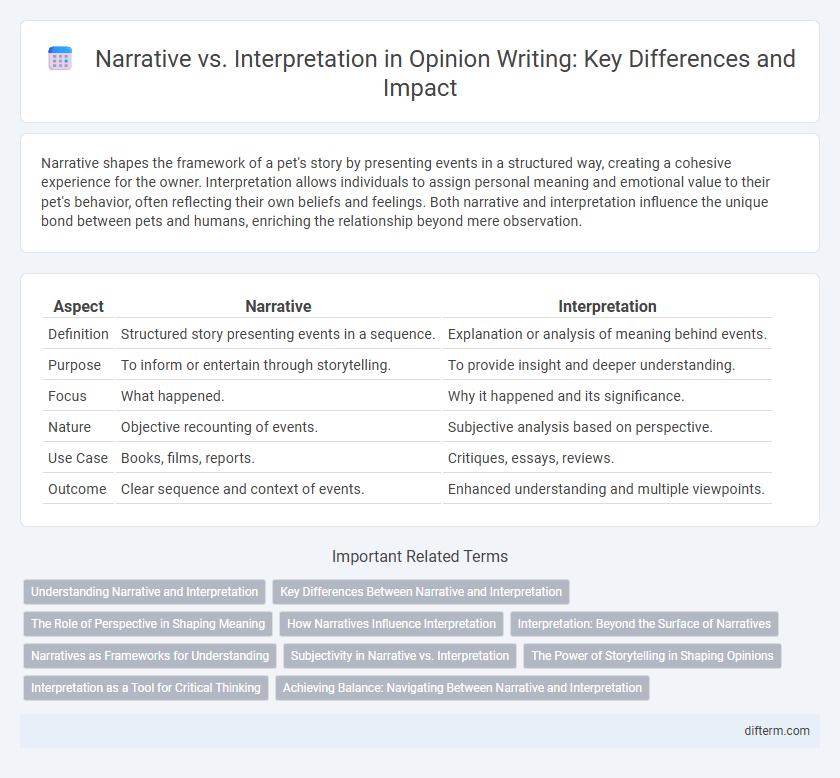Narrative shapes the framework of a pet's story by presenting events in a structured way, creating a cohesive experience for the owner. Interpretation allows individuals to assign personal meaning and emotional value to their pet's behavior, often reflecting their own beliefs and feelings. Both narrative and interpretation influence the unique bond between pets and humans, enriching the relationship beyond mere observation.
Table of Comparison
| Aspect | Narrative | Interpretation |
|---|---|---|
| Definition | Structured story presenting events in a sequence. | Explanation or analysis of meaning behind events. |
| Purpose | To inform or entertain through storytelling. | To provide insight and deeper understanding. |
| Focus | What happened. | Why it happened and its significance. |
| Nature | Objective recounting of events. | Subjective analysis based on perspective. |
| Use Case | Books, films, reports. | Critiques, essays, reviews. |
| Outcome | Clear sequence and context of events. | Enhanced understanding and multiple viewpoints. |
Understanding Narrative and Interpretation
Narrative shapes the chronological sequence of events, providing a structured framework that guides the audience through a story's development. Interpretation involves analyzing underlying meanings and perspectives, revealing deeper insights beyond the surface narrative. Understanding both narrative and interpretation enhances critical thinking by distinguishing between what is presented and how it is perceived.
Key Differences Between Narrative and Interpretation
Narrative presents a structured sequence of events that conveys a story or information, emphasizing chronology and detail. Interpretation provides analysis and meaning, offering insights and perspectives that explain or evaluate the narrative. The key difference lies in narrative's descriptive nature versus interpretation's analytical approach to understanding the underlying significance.
The Role of Perspective in Shaping Meaning
Perspective fundamentally shapes meaning by influencing how narratives are constructed and interpreted. Narratives present a sequence of events objectively, while interpretation injects subjective viewpoints that alter understanding and significance. Recognizing the role of perspective reveals the fluidity of meaning across diverse audiences and contexts.
How Narratives Influence Interpretation
Narratives shape interpretation by framing events within coherent structures that guide audience understanding and emotional response. They emphasize specific details and causal connections, which influence memory retention and meaning-making processes. This framing effect alters perception, often reinforcing particular viewpoints and biasing objective analysis.
Interpretation: Beyond the Surface of Narratives
Interpretation delves deeper than mere narrative by uncovering underlying meanings, cultural contexts, and subjective insights embedded within a story. It transcends the linear progression of events, revealing complex perspectives that shape understanding and emotional impact. Scholars emphasize that interpretation transforms narratives into dynamic experiences that engage critical thinking and personal reflection.
Narratives as Frameworks for Understanding
Narratives serve as foundational frameworks that shape how individuals and societies interpret complex information, providing structured contexts that guide meaning-making processes. By organizing events and experiences into coherent stories, narratives influence perception, memory, and cultural identity, often framing reality in ways that impact decision-making and social dynamics. Emphasizing narratives as cognitive tools highlights their role in constructing knowledge, rather than mere subjective interpretation.
Subjectivity in Narrative vs. Interpretation
Narrative often embodies subjectivity by presenting events through personal experiences, emotions, and perspectives, shaping how stories are understood. Interpretation, while influenced by individual viewpoints, strives to analyze and find meaning within narratives, balancing subjective input with critical assessment. The interplay between narrative subjectivity and interpretive objectivity highlights the complex relationship in understanding and conveying human experiences.
The Power of Storytelling in Shaping Opinions
Narrative crafts a compelling framework that guides the interpretation of facts, making storytelling a powerful tool in shaping opinions. Through emotional engagement and vivid imagery, stories influence belief systems more effectively than isolated data or abstract arguments. This dynamic illustrates how storytelling not only conveys information but also molds perceptions and drives consensus.
Interpretation as a Tool for Critical Thinking
Interpretation serves as a vital tool for critical thinking by enabling individuals to analyze and evaluate underlying meanings beyond surface narratives. It fosters deeper understanding through questioning assumptions, recognizing biases, and exploring multiple perspectives within a text or situation. By engaging in interpretive analysis, critical thinkers develop skills to discern truth, enhance reasoning, and make informed judgments.
Achieving Balance: Navigating Between Narrative and Interpretation
Achieving balance between narrative and interpretation requires understanding that the narrative provides the factual framework while interpretation offers subjective insight, allowing deeper meaning. Emphasizing clarity and coherence in storytelling helps anchor interpretation without distorting the original facts. Effective communication navigates between these elements to enrich understanding without sacrificing objectivity.
narrative vs interpretation Infographic

 difterm.com
difterm.com